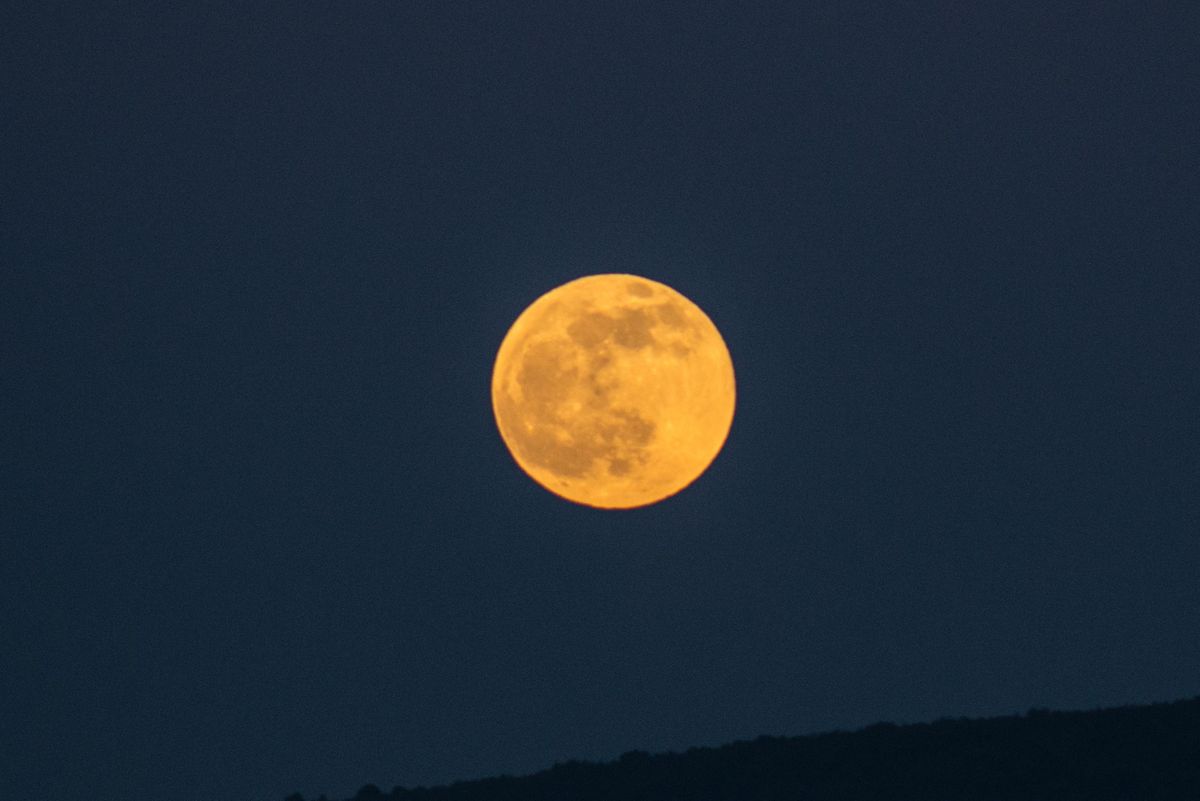A full “Wolf Moon” as seen from Greece on January 10, 2020. (Photo by Wassilios … [+]
NurPhoto via Getty Images
Each Monday I pick out the northern hemisphere’s celestial highlights (mid-northern latitudes) for the week ahead, but be sure to check my main feed for more in-depth articles on stargazing, astronomy, eclipses and more.
What To Watch For In The Night Sky This Week: January 25-31, 2021
With a full Moon in its middle, this week is not particularly good for stargazing, but rather for seeing our Solar System up close. On Tuesday, Mercury—the closest planet to the Sun—reaches the highest position above the horizon that it almost ever does, and in the post-sunset evening sky. Have a look at Mars, too, high in the southwest after dark. It’s still a great sight, but fading fast as it gets farther from Earth. It’s now or never!
In the nights that follow you can watch a waxing Moon become a full “Wolf Moon,” and then wane thereafter as it rises later each night. While the Moon’s brightness may get in the way of successful stargazing, it will still be possible to pick-out seven of the brightest stars in the night sky that together comprise the grand “Great Winter Loop” or “Winter Circle.” Found around Orion in the southeast, locating it will give you a powerful wide-eyed view of the winter night sky.
Mercury just below Venus in the desert twilight. (Photo by: Alan Dyer /VW PICS/Universal Images … [+]
Universal Images Group via Getty Images
Tuesday, January 26, 2021: Mercury at its highest
Although Mercury reached its greatest elongation east a few days ago it’s tonight after dark that it will appear at its highest above the western horizon. Mercury is not often visible because it orbits so close to the Sun, but the “swift planet” is worth looking for even just to say that you’ve seen it. It reaches its dichotomy tomorrow, when it will be 50% illuminated by the Sun (though to the naked eye and binoculars it will appear as a single point of light).
Swivel to look at the southeastern night sky anytime after dark and you’ll see a a waxing gibbous Moon—now 96% illuminated—about 3.8° from the two brightest stars in Gemini; Castor and Pollux.
Full Moon is seen in Ankara, Turkey on December 29, 2020. (Photo by Dogukan Keskinkilic/Anadolu … [+]
Anadolu Agency via Getty Images
Thursday, January 28, 2021: A full ‘Wolf Moon’ in the Beehive Cluster
Also known as the “Snow Moon” and the “Ice Moon,” January’s full Moon will be officially 100% illuminated at 19:16 Universal Time. The time to catch it will be at moonrise where you are. It will be in the constellation of Cancer, the crab, just 2.3° from the Beehive Cluster, one of the nearest open clusters of stars, of which there are around 1,000. Although it’s a good time to locate it, M44 will look better in the coming nights when the Moon has moved out of the way (binoculars will also help). Above the full Moon you’ll see Castor and Pollux once again.
Saturday, January 30, 2021: A waning Moon and Regulus
Tonight at moonrise—about three hours after sunset—you’ll see a 93%-lit waning gibbous Moon beneath bright star Regulus in the constellation of Leo, the lion. Look to the northeast and you’ll see the Big Dipper/Plough/Saucepan on its side, its handle pointing downwards.
Canis Minor constellation.
getty
Constellation of the week: Canis Minor
This two-star constellation isn’t an impressive one, but it’s important to find it because of what we’re going to see next. While Canis Major—the big dog—contains bright Sirius, just 8.6 light-years distant, the smaller Canis Minor constellation’s main bright star is Procyon. Only 11 light-years away, its name is Greek for “before the dog” because of its rising before Sirius—the “Dog Star.” It’s accompanied in Canis Major by Gomeisa, a star 180 light-years away from the Solar System.
The “Winter Loop”
Jamie Carter
Asterism of the week: the ‘Great Winter Loop’
It’s time to meet the neighbors. If you’ve been following my stargazing guides recently you’ll likely have learned how to identify a good few bright stars in and around the constellation of Orion. Now it’s time to put all that together and find arguably the most interesting sight of all for a stargazer this season—the “Great Winter Loop.” A giant asterism, or shape, its huge hexagonal pattern joins five of the brightest—and closest—15 stars in the entire night sky.
Start at Sirius, low on the horizon, and travel south to Rigel underneath Orion’s Belt. Now go up to orangey Aldebaran (not to be confused with the red planet Mars slightly further to the south), up again to bright white Capella, then turn back east to the two stars of Gemini—Castor and Pollux. Dive towards the horizon on your way back to Sirius, and you’ll find Procyon.
You’ve found one of the great circles in nature! Find, and re-find, the “Great Winter Loop” and you’ll have yourself an excellent wide-eyed view of the winter night sky. It’s invisible in summer; the Sun sits in its center every June.
Times and dates given apply to mid-northern latitudes. For the most accurate location-specific information consult online planetariums like Stellarium and The Sky Live. Check planet-rise/planet-set, sunrise/sunset and moonrise/moonset times for where you are.
Wishing you clear skies and wide eyes.
This article is auto-generated by Algorithm Source: www.forbes.com


